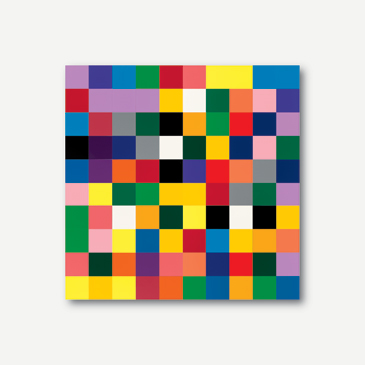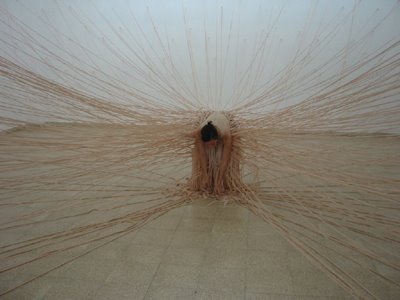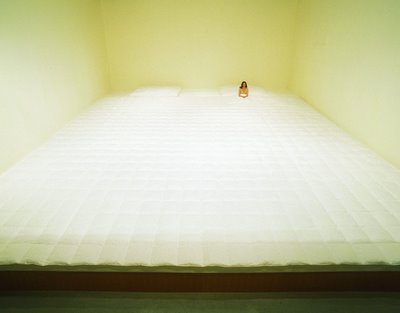The Burble is a massive structure reaching up towards the sky, composed of approximately 1000 extra-large helium balloons each of which contains microcontrollers and LEDs that create spectacular patterns of light across the surface of the structure. The public, both audience and performer, come together to control this immense rippling, glowing, bustling 'Burble' that sways in the evening sky, in response to movements of the long articulated interactive handle bar at the base of the structure. The ephemeral experience exists at such a large scale that it is able to compete visually in an urban context with the buildings that surround it.
The Burble is a massive carbon-fibre structure reaching up towards the sky, composed of approximately 1000 extra-large helium balloons each of which contains microcontrollers and LEDs that create spectacular patterns of light across the surface of the structure.
The Burble is held down to the ground by the combined weight of the crowds holding on to the handle bar. They may position it as they like. They may curve in on themselves, or pull it in a straight line - the form is a combination of the crowd's desires and the impact of wind currents varying throughout the height of the Burble.
As people on the ground shake and pump the handle bars of the Burble, they see their movements echoed as colours through the entire system. Part installation, part performance, the Burble enables people to contribute at an urban scale to a structure that occupies their city, albeit for only one night.
More info: http://www.haque.co.uk/burblelondon.php
The Burble is a massive carbon-fibre structure reaching up towards the sky, composed of approximately 1000 extra-large helium balloons each of which contains microcontrollers and LEDs that create spectacular patterns of light across the surface of the structure.
The Burble is held down to the ground by the combined weight of the crowds holding on to the handle bar. They may position it as they like. They may curve in on themselves, or pull it in a straight line - the form is a combination of the crowd's desires and the impact of wind currents varying throughout the height of the Burble.
As people on the ground shake and pump the handle bars of the Burble, they see their movements echoed as colours through the entire system. Part installation, part performance, the Burble enables people to contribute at an urban scale to a structure that occupies their city, albeit for only one night.
More info: http://www.haque.co.uk/burblelondon.php
Burble London from haque d+r on Vimeo.
Oblong's g-speak: the 'Minority Report' OS brought to life
0 Comments Published by Mark Mcleod on Saturday, November 15, 2008 at 9:23 AM.
Not really an art post, but I could see where this has tremendous possibilities for the arts. Similar to the movie "Minority Report".
from serpentine gallery:
"Gerhard Richter (born Dresden, 1932) is one of the world’s greatest living artists. Since the early 1960s he has tirelessly explored the medium of painting at a time when many were heralding its death. He has produced a remarkably varied body of work, including photography-based portrait, landscape and still-life paintings; gestural and monochrome abstractions; and colour chart grid paintings. This autumn, the Serpentine presents 4900 Colours, a major new work comprising bright monochrome squares randomly arranged in a grid formation to create stunning sheets of kaleidoscopic colour.
4900 Colours comprises 196 square panels of 25 coloured squares that can be reconfigured in a number of variations, from one large-scale piece to multiple, smaller paintings. Richter has developed a new version especially for the Serpentine Gallery exhibition: 4900 Colours: Version II, formed of 49 paintings of 100 squares.
4900 Colours is in the context of Richter’s design for the south transept window of Cologne Cathedral, which replaced the stained glass that was destroyed in World War II. Cathedral Window, unveiled in August 2007, comprises 11,500 hand-blown squares of glass in 72 colours that are derived from the palette of the original medieval glazing."

"Gerhard Richter (born Dresden, 1932) is one of the world’s greatest living artists. Since the early 1960s he has tirelessly explored the medium of painting at a time when many were heralding its death. He has produced a remarkably varied body of work, including photography-based portrait, landscape and still-life paintings; gestural and monochrome abstractions; and colour chart grid paintings. This autumn, the Serpentine presents 4900 Colours, a major new work comprising bright monochrome squares randomly arranged in a grid formation to create stunning sheets of kaleidoscopic colour.
4900 Colours comprises 196 square panels of 25 coloured squares that can be reconfigured in a number of variations, from one large-scale piece to multiple, smaller paintings. Richter has developed a new version especially for the Serpentine Gallery exhibition: 4900 Colours: Version II, formed of 49 paintings of 100 squares.
4900 Colours is in the context of Richter’s design for the south transept window of Cologne Cathedral, which replaced the stained glass that was destroyed in World War II. Cathedral Window, unveiled in August 2007, comprises 11,500 hand-blown squares of glass in 72 colours that are derived from the palette of the original medieval glazing."


